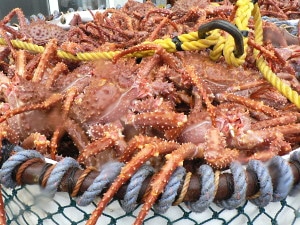
Bycatch of crab occurs both in directed crab pot fisheries, as well as groundfish and scallop fisheries. In the crab fisheries, the discarded crabs include females of the target species, sublegal males of the target species (males that are smaller than the minimum size limit), and non-target crab. In all other fisheries, crabs are a prohibited species that must be discarded, so every crab caught incidentally is considered bycatch.
Crabs caught as bycatch in trawl fisheries are thought to have a high mortality rate (estimated at 80%); in the scallop dredge and pot fisheries for crab and groundfish, mortality is considered to be much lower (between 20% and 50%).
Crab Bycatch Reduction Measures in the Groundfish and Scallop Fisheries
Limits on the bycatch of prohibited crab species have been established in some Bering Sea fisheries, to reduce the impacts on these species traditionally harvested by other gear types.
Bycatch limits: When bycatch limits are reached, fisheries responsible for the bycatch are closed for the rest of the season, or are prohibited from fishing in areas with historically high bycatch rates. Crab bycatch limits (known as prohibited species catch limits, or PSC limits) have been established for the trawl fisheries in the BSAI to protect red king crab, Tanner crab, and snow crab. The limits fluctuate based on annual estimates of crab abundance.
Area closures: Area closures for trawl vessels have also been implemented throughout the Bering Sea/Aleutian Islands (BSAI) and Gulf of Alaska (GOA) to protect crab. Several year-round and seasonal closures exist in Bristol Bay and around the Pribilof Islands, to increase protection for adult and juvenile crab and their habitat, as well as closures around Kodiak, southeast Alaska, Cook Inlet, and inside State waters. Additionally, year-round scallop closures to scallop dredging are intended to reduce bycatch of crab and to avoid and protect biologically critical areas such as nursery areas for groundfish and shellfish.
Gear restrictions: Since the 1980s, the Council has also implemented other measures to reduce crab bycatch in groundfish fisheries. Gillnets for groundfish are prohibited to prevent ghost fishing and bycatch of non-target species. Groundfish pots are required to have biodegradable panels and tunnel openings of a limited size to reduce incidental catch and ghost fishing from lost gear. Additionally, the use of bottom trawl gear is prohibited for vessels targeting pollock in the Bering Sea, to reduce crab and halibut bycatch, and a trawl sweep modification is required for vessels participating in the Bering Sea and GOA flatfish fisheries, to raise the trawl sweep off the seafloor and reduce unobserved mortality of crab.
Staff contact is Anita Kroska.



